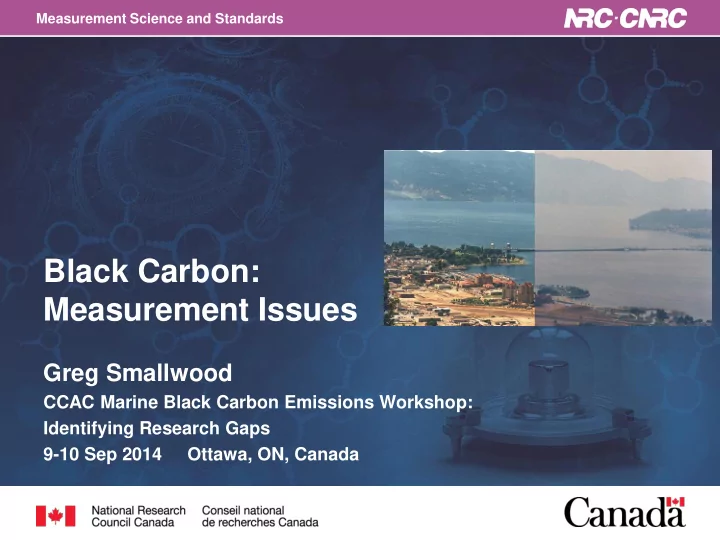

Measurement Science and Standards Black Carbon: Measurement Issues Greg Smallwood CCAC Marine Black Carbon Emissions Workshop: Identifying Research Gaps 9-10 Sep 2014 Ottawa, ON, Canada
What Needs to be Measured? • health and environmental researchers and policymakers are asking for more specificity on PM – mass and number – size and size distribution – composition (black carbon, organic carbon, sulphates, nitrates) – surface area and surface reactivity – optical properties (absorption and scattering) • BC provides specificity on composition – what should be measured for BC? • mass • number • absorption • other measurands (size distribution, surface coatings, etc.)? 2 Measurement Science and Standards
Measurement Issues (I) Traceability • many instruments offer no opportunity for traceability • filter-based mass can be traceable – issues with sensitivity (mass of particulate vs. mass of filter) – issues with filter artifacts • gaseous adsorption • fibre loss • less than 100% removal efficiency – issues with size cutoff • impactors and cyclones do not cut sharply at threshold (i.e. PM 2.5 ) • number concentration can be made traceable – ISO/FDIS 27891 - Aerosol particle number concentration -- Calibration of condensation particle counters 3 Measurement Science and Standards
Measurement Issues (II) Reliability and Repeatability • difficult to establish Uncertainty • large uncertainties (can be order of magnitude in number, factor of 2 in mass) Reference Materials • airborne particulate RMs don’t exist Representativeness • all ex-situ methods suffer from sampling issues – how representative is the sample at the measurement location of the airborne particulates? • losses – diffusion, thermophoretic,impaction ,… • agglomeration • evaporation/condensation 4 Measurement Science and Standards
Measurement Issues (III) Measuring properties with different methods • most instruments are proprietary – each manufacturer implements a different measurement principle • difficult to intercompare results obtained with different instruments • example – black carbon mass • directly measured, or inferred from optical absorption, extinction, or emission measurements Calibration • is the instrument calibrated with a standard method? • what is the uncertainty? 5 Measurement Science and Standards
Measurement Issues (IV) Measuring specific properties with a myriad of interferences • selectivity – how does one measure properties of BC when many other PM components are present? • sensitivity – atmospheric concentrations are often very low (<1 µg/m 3 ) • gas composition – can be highly variable, especially in engine exhausts – can influence measurement • morphology – spherical particles vs. fractal aggregates • single particle vs. ensemble measurements • variations over time, elevation, temperature, humidity, sunlight, etc. 6 Measurement Science and Standards
Examples of Instruments used to Measure BC: Mass (top row) and Morphology/Size/Number (lower row) Laser Induced Gravimetric Thermal Optical Incandescence Centrifugal Particle EC/OC Analyzer Mass Analyzer Electrostatic Fast Particle Scanning Mobility Precipitator Condensation Mobility Size Particle Sizer Particle Counter Spectrometer HR-TEM 7 Measurement Science and Standards
Thank you Dr. Gregory J. Smallwood Program Leader, Metrology for Industry and Society phone: 613-993-1391 e-mail: greg.smallwood@nrc-cnrc.gc.ca web: www.nrc-cnrc.gc.ca Measurement Science and Standards
Definition for Black Carbon “Black Carbon is a distinct type of carbonaceous material that is formed primarily in flames, is directly emitted to the atmosphere, and has a unique combination of physical properties” • strongly absorbs visible light • is refractory with a vaporization temperature near 4000 K • exists as an aggregate of small spheres • is insoluble in water and common organic solvents Bond et al., “Bounding the role of black carbon in the climate system: A scientific assessment,”Journal of Geophysical Research – Atmospheres, 118, (2013) 9 Measurement Science and Standards
Recommend
More recommend